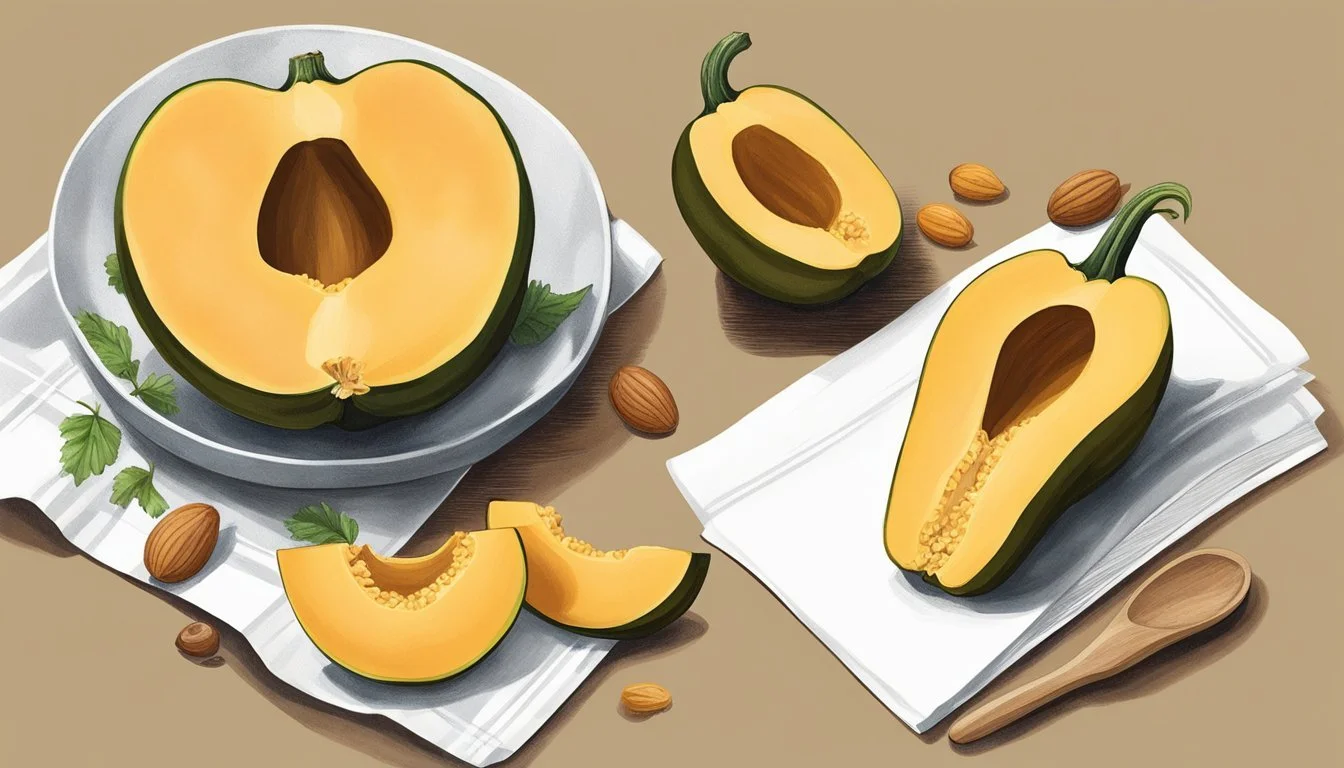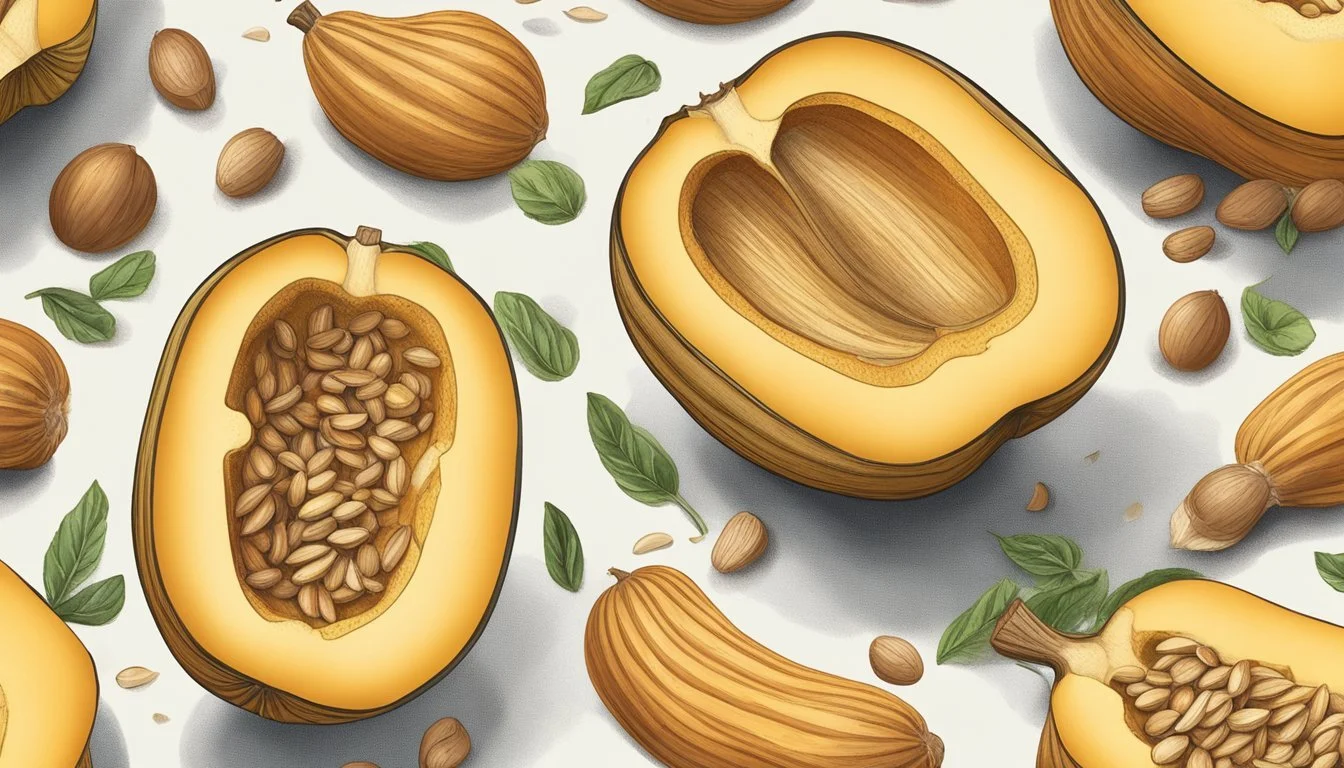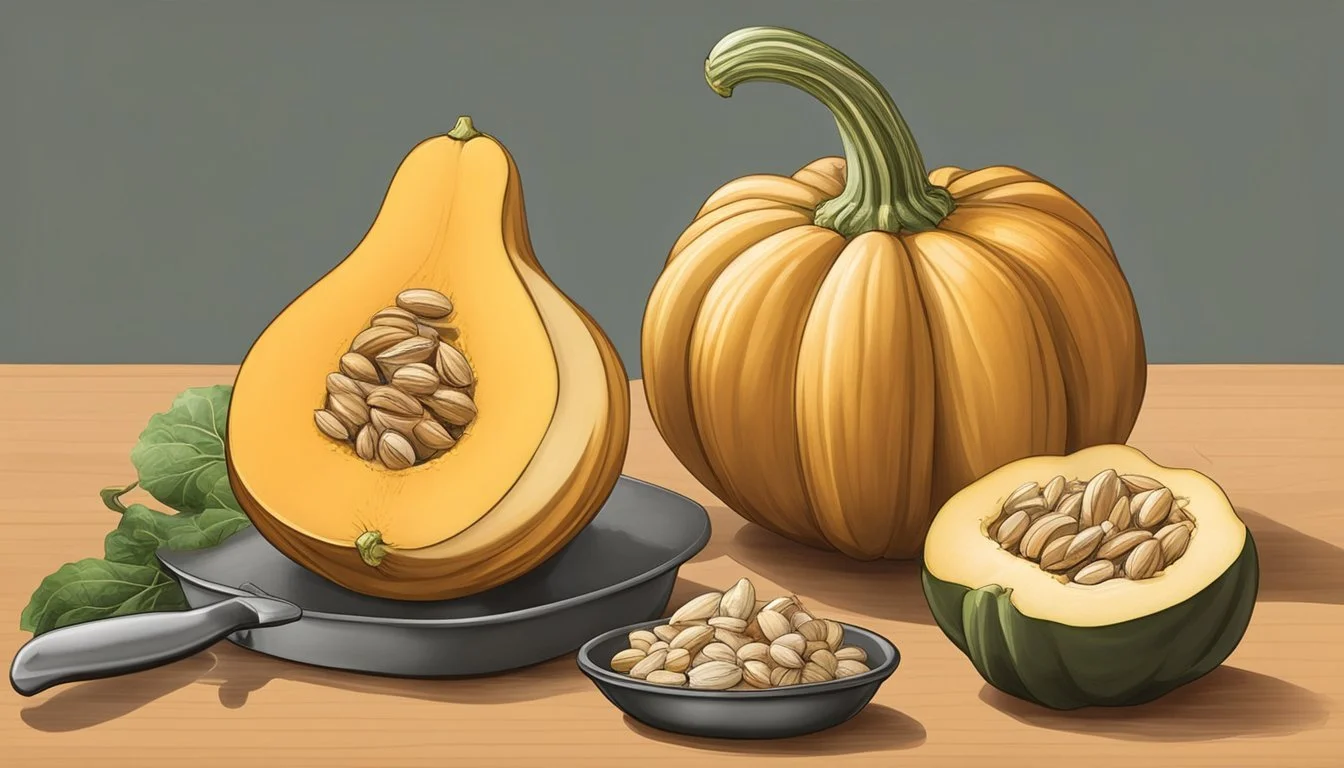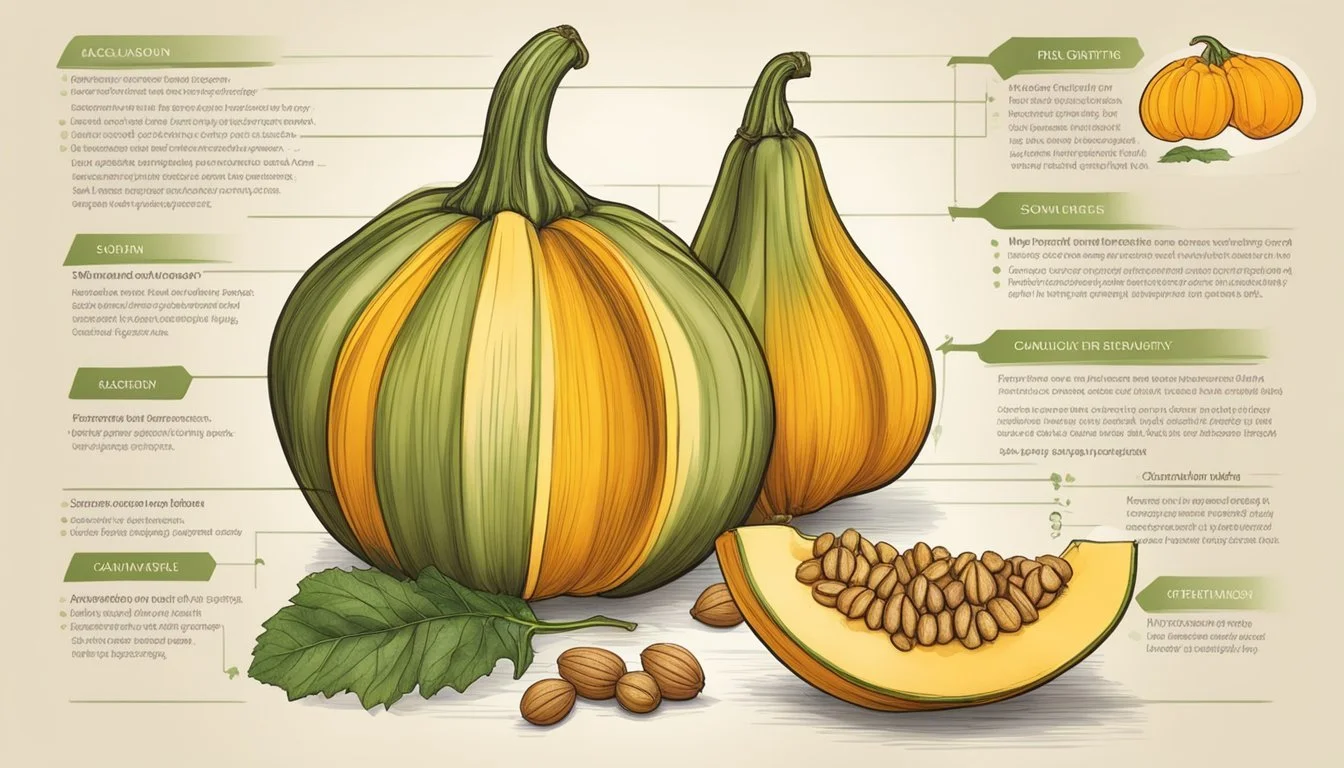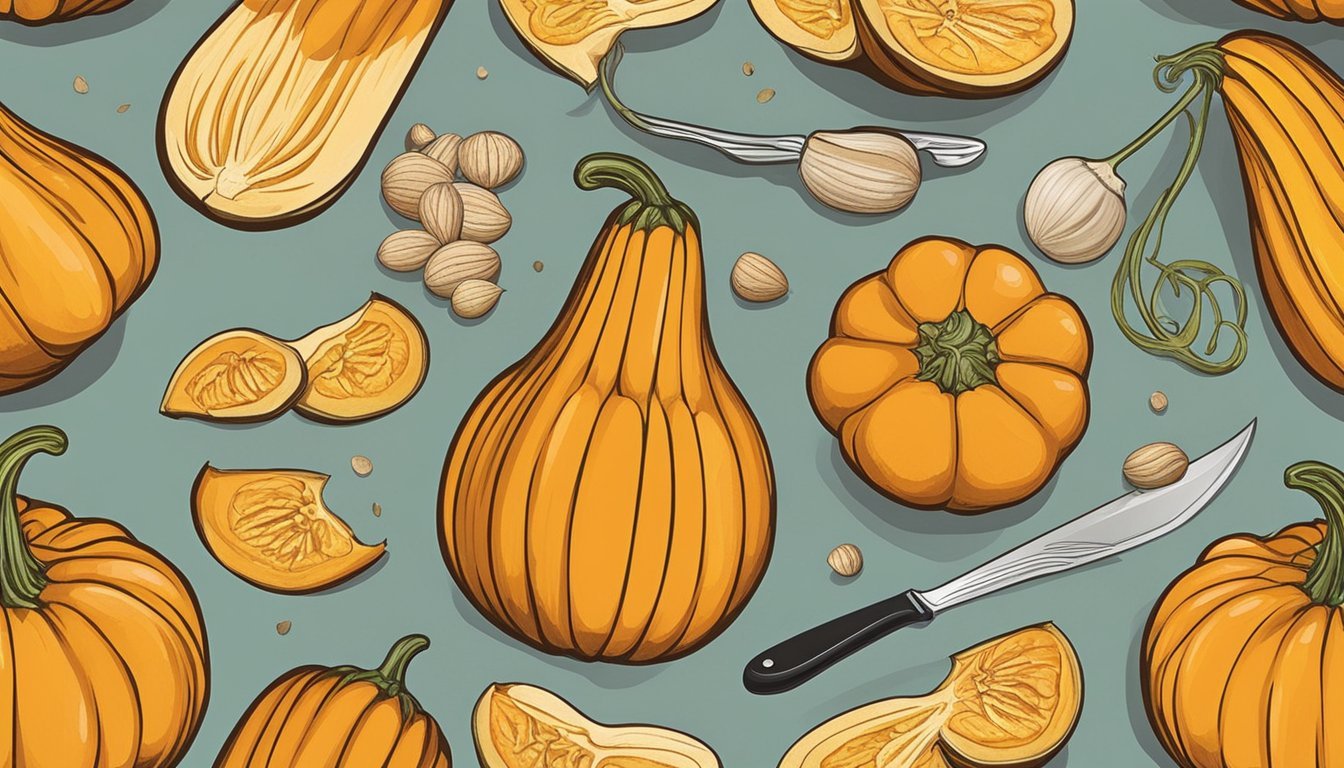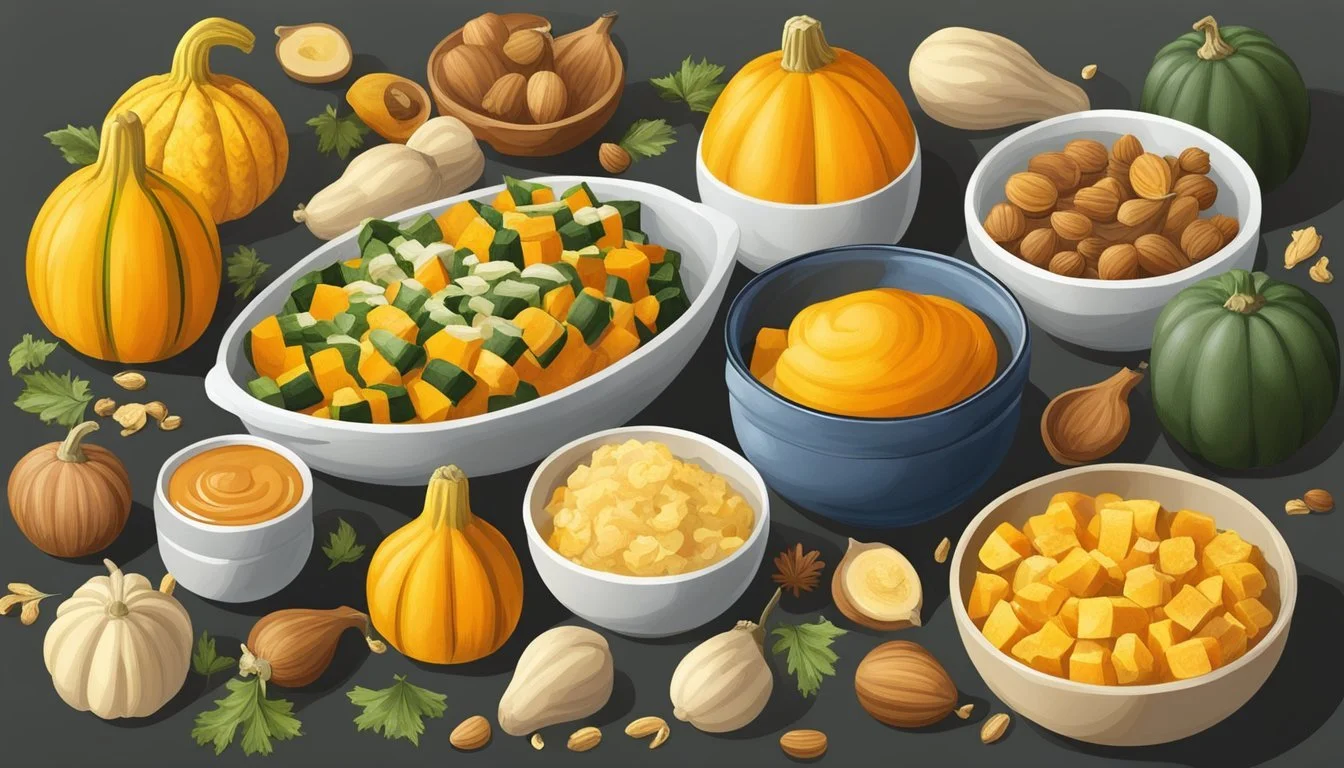How to Substitute Honeynut Squash for Acorn Squash
A Simple Guide
Honeynut squash and acorn squash are versatile ingredients that can be interchanged in many recipes to accommodate availability or personal preference. Honeynut squash is a smaller, sweeter variant of butternut squash, with a flavor profile that is rich and nutty. Its size makes it an ideal choice for single servings or small households, generally weighing between 1 and 2 pounds. The skin of honeynut squash is notably thin and edible, which provides an added element of texture to dishes.
On the other hand, acorn squash is recognized for its distinctive shape and slightly more fibrous texture. It is larger than honeynut squash, usually ranging from 2 to 3 pounds, making it suitable for meals intended for larger groups. The mild, somewhat nutty flavor of acorn squash pairs well with both sweet and savory ingredients, lending itself to a variety of culinary uses.
Substituting honeynut squash for acorn squash can be a simple and effective way to explore new flavors and textures in familiar recipes. Due to the size difference, adjustments in portion size and cooking time may be necessary. The inherent sweetness and creamy texture of honeynut squash can enrich recipes, providing a fresh take on classic acorn squash dishes.
Understanding Squash Varieties
Squash is a versatile and nutritious vegetable that comes in many shapes and sizes, each with its own unique flavor profile and texture. This section examines the distinctions between different winter squash, especially focusing on Honeynut and Acorn varieties, to guide substitutions in recipes.
Winter Squash Overview
Winter squash refers to a group of squash that is harvested in the fall, has a hard shell, and can be stored for use throughout the winter. Common types include butternut, delicata, kabocha, buttercup, and hubbard squash. These varieties are known for their rich, sweet flavors and are often used in soups, pies, and as roasted vegetables.
Butternut Squash: Creamy beige skin, bell-like shape, sweet and nutty flavor.
Delicata Squash: Cylinder-shaped, cream-colored with green stripes, sweet and tender flesh.
Kabocha Squash: Green or orange skin, round and squat, with a texture reminiscent of sweet potatoes.
Buttercup Squash: Turban shape, dark green skin with a grey "cap", dense and creamy texture.
Hubbard Squash: Large and teardrop-shaped, with a bumpy, blue-grey or orange outer skin, savory and slightly grainy flesh.
Characteristics of Honeynut Squash
Honeynut squash is a tiny powerhouse with a deep orange skin that indicates its high beta-carotene content. It's a miniature version of the butternut, measuring about 6 inches in length with a sweet, concentrated flavor. Thanks to its size, Honeynut squash is perfect for single servings.
Size: Around 1 to 2 pounds, 6 inches in length, ideal for single servings.
Flavor: Rich, caramelized sweetness when roasted.
Texture: Smooth and creamy.
Characteristics of Acorn Squash
Acorn squash, recognizable by its ridged acorn-like shape, is a staple when it comes to winter squash. With an average weight of 2 to 3 pounds, it suits larger portions and can be easily filled or mixed into various dishes.
Size: Approximately 2 to 3 pounds, larger than Honeynut, suits meals for multiple people.
Flavor: Mild with a hint of nuttiness, becomes sweeter when baked.
Texture: Firmer and slightly fibrous, holds its shape well when cooked.
Nutritional Profiles
When substituting Honeynut squash for Acorn squash in recipes, it's important to consider their nutritional profiles. Both squashes offer valuable nutrients, but they differ in levels of vitamin A, fiber, and minerals, which can influence their health benefits.
Vitamin A and Fiber Content
Honeynut squash is high in vitamin A, providing a significant amount with each serving. It contains a deep orange flesh indicative of beta-carotene, which the body converts into vitamin A. This nutrient is essential for maintaining good vision, skin health, and immune function. In terms of fiber, both Honeynut and Acorn squash offer a good amount, which is beneficial for digestive health. A high fiber diet can promote a feeling of fullness, which may aid in weight management.
Vitamin A: Honeynut squash contains more beta-carotene compared to Acorn squash.
Fiber: Both varieties provide dietary fiber, but Honeynut squash typically has a slightly higher fiber content per serving.
Mineral Richness
Both Honeynut and Acorn squash are sources of important minerals, such as potassium, which supports heart health by helping to maintain normal blood pressure. They also contain magnesium and manganese, which are essential for bone health and metabolic functions. However, the smaller size of Honeynut squash may mean that when substituting it for Acorn squash, one might need more of it to match the mineral content found in larger portions of Acorn squash.
Potassium: Essential for heart health and found in both types of squash.
Magnesium and Manganese: Important for various bodily functions and present in both squashes, although the actual amounts can vary.
In summary, while both Honeynut and Acorn squash contribute positively to a healthy diet, their nutritional profiles should be considered during substitution to maintain the intended nutritional value of the dish.
Preparation Techniques
Substituting honeynut squash for acorn squash involves similar preparation methods. The distinctions in texture and size between the two squashes call for careful attention to peeling, seeding, and roasting techniques to ensure a flavorful and well-cooked dish.
To Peel or Not to Peel
Honeynut squash has a thinner, more delicate skin compared to acorn squash, which often leads to the decision that there is no need to peel it before cooking. If one chooses to peel, a sharp knife or vegetable peeler can make the job easier. The peel is edible and softens when roasted, so peeling is a matter of personal preference and presentation.
Seeding and Cutting
Before roasting, both honeynut and acorn squashes require seeding. Cut the squash in half lengthwise and utilize a spoon to remove the seeds. Honeynut squash, typically smaller in size than acorn squash, may be halved or cut into slices depending on the recipe. Always use a sharp knife to ensure clean cuts and safety.
Roasting Methods
Roasting honeynut squash brings out its naturally sweet flavors much like acorn squash. Start by preheating the oven to 400°F. Place the squash on a baking sheet lined with parchment paper to prevent sticking. Drizzle each half with olive oil, and if desired, sprinkle with seasonings. The squash should be roasted cut-side down until it is easily pierced by a fork, typically 30 to 45 minutes for honeynut squash. Roasted honeynut squash is ready when it has a caramelized exterior and a fork-tender interior.
Culinary Uses
When substituting honeynut squash for acorn squash in recipes, consider the sweetness and size of the honeynut squash. Its flavor is similar to butternut squash but much sweeter, and it's smaller than an acorn squash.
Squash as a Side Dish
Roasted honeynut squash makes an excellent side dish due to its natural sweetness and smooth texture. To replace acorn squash, one can cut the honeynut squash in half, remove the seeds, and roast it cut-side up until tender. It can be seasoned simply with salt, pepper, and a drizzle of olive oil or enhanced with spices like cinnamon or nutmeg for a richer flavor.
Example of a recipe adjustment:
Acorn squash recipe: Roast at 400ºF for 30 to 45 minutes.
Honeynut substitute: Roast at 400ºF for 20 to 25 minutes.
Squash in Soups and Stews
Honeynut squash can replace acorn squash in soups and stews to add depth and sweetness. It pairs well with ingredients like carrots, celery, and onions. The squash should be peeled, cubed, and added to the dish, taking care to adjust cooking times due to its smaller size and quicker cooking property.
Soup/Stew Tip: For a creamier texture, blend some or all of the cooked squash before adding it back into the pot.
Baking with Squash
In baking, honeynut squash brings moisture and sweetness similar to a sweet potato casserole. When substituting for acorn squash in stuffed recipes or casseroles (What wine goes well with casseroles?), remember that honeynut squash's smaller size might require less baking time or a larger quantity to match the original recipe’s volume.
Baking Adjustments:
Stuffed squash: Halve the baking time and monitor for tenderness.
Casseroles: Increase honeynut squash quantity to retain volume and sweetness.
Flavor Pairings
When substituting Honeynut squash for Acorn squash, it's essential to consider complementary flavor pairings to enhance the natural sweetness and nuttiness of the squash.
Herbs and Spices
Pairing the right herbs and spices can greatly accentuate the sweet and nutty profile of Honeynut squash. The use of:
Cinnamon: Adds a warm, sweet spice that complements the Honeynut's sweetness.
Nutmeg: Offers a slightly nuttier spice, pairing well with the natural flavor.
Ginger: Provides a zesty bite that contrasts the squash's sweetness.
Rosemary: Its piney aroma can add depth to the Honeynut's flavor.
Black Pepper: A classic spice that adds a sharp, earthy kick.
These spices can be sprinkled on roasted Honeynut squash or mixed into fillings for a more complex flavor.
Cheese and Nuts Combinations
Cheese and nut pairings create a rich, textural experience that resonates with the creamy texture of the Honeynut squash. Ideal combinations include:
Goat Cheese: Its tangy freshness cuts through the squash’s natural sweetness.
Pecans and Walnuts: Toasted, they add a crunchy contrast to the soft flesh of the squash.
A sprinkle of sea salt helps to balance the flavors and bring out the best in these pairings.
Sweet and Savory Enhancers
To elevate both sweet and savory elements:
Pure Maple Syrup or Honey: Drizzling either enhances the inherent sugary notes without overpowering.
Olive Oil: Adds a fruity and slightly bitter counterpoint to the squash's flavor and aids in caramelization when roasting.
Pumpkin Seeds: Offer a savory note with added crunch.
Coupled with a dash of salt and pepper, these enhancers can round off the dish, ensuring every bite is as flavorful as the last.
Texture and Color Considerations
When substituting Honeynut squash for Acorn squash, one must consider the texture and color differences that could affect the dish's visual and sensory appeal.
Consistency in Cooking
Honeynut squash tends to have a denser flesh than Acorn squash, resulting in a slightly creamier texture upon cooking. Its small, compact size means it usually cooks faster. Chefs should adjust cooking times to prevent a mushy consistency or unevenly cooked pieces. For dishes requiring a firmer texture, monitoring the cooking process closely will help maintain the desired consistency.
Presentation and Visual Appeal
The vibrant orange flesh of the Honeynut squash can offer a more enhanced visual presentation compared to the paler Acorn squash. When caramelized, Honeynut squash's sugars contribute to a rich golden-brown color, which adds an appetizing appeal to the dish. The fact that its skin is edible eliminates the need for peeling, presenting a rustic and natural look in the final presentation. Use this characteristic to add contrast and interest to the plating of the dish.
Substitution Strategies
In the realm of squash varieties, the Honeynut offers a robust flavor and a size well-suited to replacing Acorn squash in a recipe. The key strategy involves understanding the appropriate scenarios for substitution and making necessary adjustments in quantity to align with recipe requirements.
When to Substitute Honeynut for Acorn Squash
One can opt for Honeynut squash as a substitute for Acorn squash in situations where a sweeter, more intense flavor is desired. Honeynut is smaller but denser than Acorn squash, which makes it a concentrated source of flavor. It is versatile enough to fit into most recipes that call for Acorn squash, particularly in sweet or baked dishes. However, its smaller size means that it may not be the best substitute for recipes that rely on the larger cavity of Acorn squash for stuffing.
Reasons to Substitute:
Increase sweetness
Enhance flavor
Smaller serving sizes
Ratio and Quantity Adjustments
When substituting Honeynut for Acorn squash, a cook should consider the variance in size and adjust the quantity accordingly. Typically, one might use two Honeynut squashes for every Acorn squash specified in a recipe.
Adjustment Guide:
Acorn Squash Honeynut Squash 1 whole 2 whole 1 cup diced 1 1/3 cups diced
These adjustments ensure that the overall volume and flavor profile of the dish remain consistent with the recipe's intention. The cook should note that while Honeynut can replicate the taste and texture of Acorn squash, variations in moisture content might slightly alter cooking times.
Seasonal and Regional Availability
When planning to substitute Honeynut squash for Acorn squash, understanding their availability throughout the year is crucial. These squashes are seasonal, with peak availability often aligning with their prime harvest times.
Harvest Seasons
Honeynut squash typically ripens by late September and remains available through December. Its smaller size relative to Acorn squash results from selective breeding for taste and a compact form, making its harvest quite predictable. Acorn squash also follows a similar harvest cycle, becoming available in autumn and continuing through the winter months.
Farmers Market Finds
At farmers markets, one can often find the freshest Honeynut and Acorn squashes during their respective harvest seasons. Shoppers may even encounter varieties in farmers markets that are not available in larger chain stores. While stores like Trader Joe’s carry these squashes, their stock may vary by region and seasonal availability. It's beneficial for consumers to visit local farmers markets to acquire the freshest produce directly from the source.
Ideal Dishes for Squash Varieties
When substituting honeynut squash for acorn squash, chefs should consider the texture and sweetness that honeynut squash brings to a dish, making it well-suited for both classic Thanksgiving recipes and inventive everyday meals.
Thanksgiving Favorites
Honeynut squash's rich flavor profiles embody the essence of Thanksgiving dishes. A prime example is a Roasted Honeynut Squash filled with quinoa, dried cranberries, and roasted garlic, creating a hearty and flavorful side. When it comes to a traditional Squash Casserole, substituting honeynut squash offers a sweeter twist, pairing exceptionally well with parmesan topping and a hint of maple to embrace the fall theme.
Squash and Sweet Potato Gratin: Layer thin slices of honeynut squash and sweet potato, seasoned with salt and nutmeg, and baked to perfection with a parmesan crust.
Maple Glazed Squash: Cubes of honeynut squash tossed in maple syrup, cinnamon, and a touch of salt bake into a caramelized, sweet side dish that complements the savory Thanksgiving spread.
Creative Everyday Recipes
For day-to-day cooking, honeynut squash's versatility shines through in simple yet delicious recipes. It can be the star in Pumpkin-Squash Soup, providing a creamy base that can be amplified with a touch of garlic and a swirl of cream. Additionally, a Squash Risotto turns a weeknight meal into a luxurious dining experience; the innate sweetness of the squash balances the savory depth of garlic and the umami from parmesan cheese.
Stuffed Squash Boats: Halve and bake honeynut squash, then stuff with a savory mixture of sautéed garlic, vegetables, and quinoa for a balanced, easy to make meal.
Squash Pasta Sauce: Blend roasted honeynut squash with garlic and parmesan to create a smooth, rich sauce for pasta—an easy side dish that's both comforting and satisfying.
By thoughtfully incorporating honeynut squash into these dishes, cooks will achieve meals that are both original and rooted in tradition.
Additional Tips and Tricks
When substituting honeynut squash for acorn squash, it's crucial to consider factors like texture and cook time to ensure a successful dish. Below are practical tips and tricks to help maintain the integrity and flavor of your squash dishes.
Making the Perfect Squash Dish
To ensure the perfect texture, remember that honeynut squash often has a softer consistency than acorn squash upon cooking. As a result, honeynut squash may require a shorter cook time. To test for doneness, use a fork to pierce the squash; it should be tender but not mushy. For a delightful glaze that complements the naturally sweet and nutty flavor of honeynut squash, a combination of olive oil, maple syrup, and a sprinkle of red pepper flakes can elevate the taste. Consider adding a dash of green herbs for color and flavor contrast.
Here's a sample glaze recipe for your squash:
2 tbsp olive oil
2 tbsp maple syrup
A pinch of red pepper flakes
Fresh herbs for garnish (optional)
Michael Mazourek from Cornell University, who played a pivotal role in the development of the honeynut squash, suggests that its natural sweetness and rich, nutty flavor make it ideal for a variety of vegan squash recipes. The squash's vibrant orange color also makes a visually appealing addition to any meal.
Storing and Preserving Squash
Proper storage of squash can extend its shelf life. Honeynut squash should be kept in a cool, dry place and can last for a few weeks. If a large quantity of squash is prepared and not all of it is used, it can be stored in the refrigerator for a few days in an airtight container. For longer preservation, one can dice the cooked squash and freeze it in sealable bags, ensuring a quick and convenient addition to future meals. Diced squash is also corn-centric as it can easily accompany corn in dishes to bring out a balance of sweet and savory flavors.

